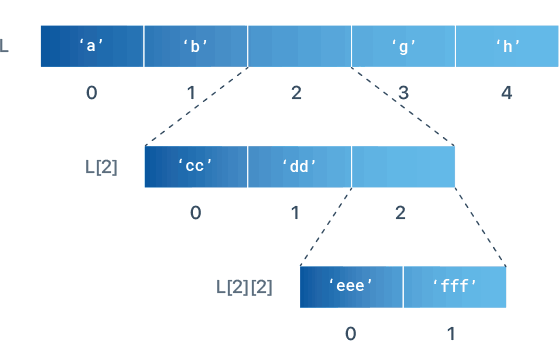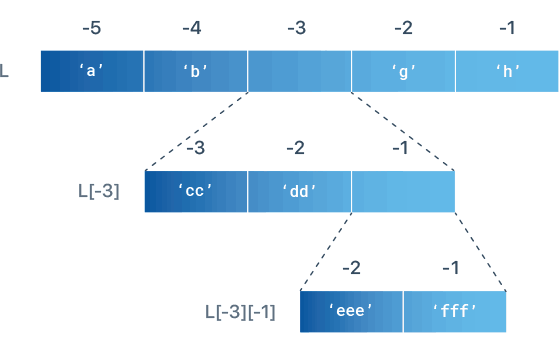how to add numbers in a list python
What is Python Nested List?
A list can contain any sort object, even another list (sublist), which in turn can contain sublists themselves, and so on. This is known as nested list.
You can use them to arrange data into hierarchical structures.
Create a Nested List
A nested list is created by placing a comma-separated sequence of sublists.
L = ['a', ['bb', ['ccc', 'ddd'], 'ee', 'ff'], 'g', 'h'] Access Nested List Items by Index
You can access individual items in a nested list using multiple indexes.
The indexes for the items in a nested list are illustrated as below:

L = ['a', 'b', ['cc', 'dd', ['eee', 'fff']], 'g', 'h'] print(L[2]) # Prints ['cc', 'dd', ['eee', 'fff']] print(L[2][2]) # Prints ['eee', 'fff'] print(L[2][2][0]) # Prints eee Negative List Indexing In a Nested List
You can access a nested list by negative indexing as well.
Negative indexes count backward from the end of the list. So,L[-1] refers to the last item,L[-2] is the second-last, and so on.
The negative indexes for the items in a nested list are illustrated as below:

L = ['a', 'b', ['cc', 'dd', ['eee', 'fff']], 'g', 'h'] print(L[-3]) # Prints ['cc', 'dd', ['eee', 'fff']] print(L[-3][-1]) # Prints ['eee', 'fff'] print(L[-3][-1][-2]) # Prints eee Change Nested List Item Value
You can change the value of a specific item in a nested list by referring to its index number.
L = ['a', ['bb', 'cc'], 'd'] L[1][1] = 0 print(L) # Prints ['a', ['bb', 0], 'd'] Add items to a Nested list
To add new values to the end of the nested list, use append() method.
L = ['a', ['bb', 'cc'], 'd'] L[1].append('xx') print(L) # Prints ['a', ['bb', 'cc', 'xx'], 'd'] When you want to insert an item at a specific position in a nested list, use insert() method.
L = ['a', ['bb', 'cc'], 'd'] L[1].insert(0,'xx') print(L) # Prints ['a', ['xx', 'bb', 'cc'], 'd'] You can merge one list into another by using extend() method.
L = ['a', ['bb', 'cc'], 'd'] L[1].extend([1,2,3]) print(L) # Prints ['a', ['bb', 'cc', 1, 2, 3], 'd'] Remove items from a Nested List
If you know the index of the item you want, you can use pop() method. It modifies the list and returns the removed item.
L = ['a', ['bb', 'cc', 'dd'], 'e'] x = L[1].pop(1) print(L) # Prints ['a', ['bb', 'dd'], 'e'] # removed item print(x) # Prints cc If you don't need the removed value, use the del statement.
L = ['a', ['bb', 'cc', 'dd'], 'e'] del L[1][1] print(L) # Prints ['a', ['bb', 'dd'], 'e'] If you're not sure where the item is in the list, use remove() method to delete it by value.
L = ['a', ['bb', 'cc', 'dd'], 'e'] L[1].remove('cc') print(L) # Prints ['a', ['bb', 'dd'], 'e'] Find Nested List Length
You can use the built-in len() function to find how many items a nested sublist has.
L = ['a', ['bb', 'cc'], 'd'] print(len(L)) # Prints 3 print(len(L[1])) # Prints 2 Iterate through a Nested List
To iterate over the items of a nested list, use simple for loop.
L = [[1, 2, 3],[4, 5, 6],[7, 8, 9]] for list in L: for number in list: print(number, end=' ') # Prints 1 2 3 4 5 6 7 8 9 how to add numbers in a list python
Source: https://www.learnbyexample.org/python-nested-list/
Posted by: doylecriall97.blogspot.com

0 Response to "how to add numbers in a list python"
Post a Comment